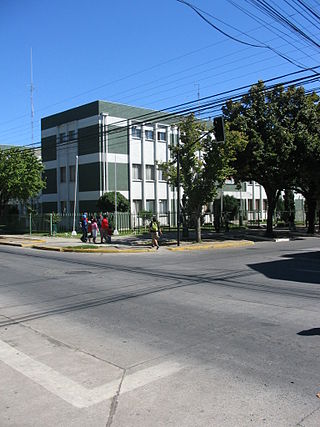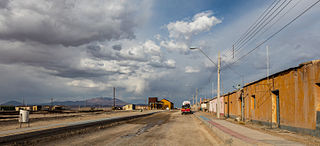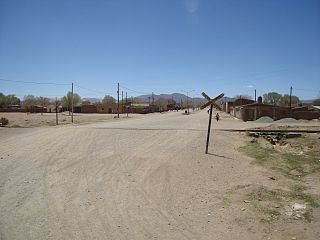
Iquique Province is one of two provinces in the northern Chilean region of Tarapacá. Its capital is the port city of Iquique.

Los Ángeles is the capital of the province of Bío Bío, in the commune of the same name, in Bío Bío, in the center-south of Chile. It is located between the Laja and Biobío rivers. The population is 186,671 inhabitants. The municipality ("comuna") of Los Ángeles has the highest absolute rural population of any Chilean municipality.

Arica is a commune and a port city with a population of 222,619 in the Arica Province of northern Chile's Arica y Parinacota Region. It is Chile's northernmost city, being located only 18 km (11 mi) south of the border with Peru. The city is the capital of both the Arica Province and the Arica and Parinacota Region. Arica is located at the bend of South America's western coast known as the Arica Bend or Arica Elbow. At the location of the city are two valleys that dissect the Atacama Desert converge: Azapa and Lluta. These valleys provide citrus and olives for export.

Calama is a city and commune in the Atacama Desert in northern Chile. It is the capital of El Loa Province, part of the Antofagasta Region. Calama is one of the driest cities in the world with average annual precipitation of just 5 mm (0.20 in). The River Loa, Chile's longest, flows through the city. Calama has a population of 147,886.

Iquique is a port city and commune in northern Chile, capital of both the Iquique Province and Tarapacá Region. It lies on the Pacific coast, west of the Pampa del Tamarugal, which is part of the Atacama Desert. It has a population of 191,468 according to the 2017 census. It is also the main commune of Greater Iquique. The city developed during the heyday of the saltpetre mining in the Atacama Desert in the 19th century. Once a Peruvian city with a large Chilean population, it was conquered by Chile in the War of the Pacific (1879–1883). Today it is one of only two free ports of Chile, the other one being Punta Arenas, in the country's far south.

The Tarapacá Region is one of Chile's 16 first-order administrative divisions. It comprises two provinces, Iquique and Tamarugal. It borders the Chilean Arica y Parinacota Region to the north, Bolivia's Oruro Department and Potosí Department on the east, Chile's Antofagasta Region to the south and the Pacific Ocean to the west. The port city of Iquique is the region's capital.
Huara is a Chilean town and commune in Tamarugal Province, Tarapacá Region. It is located 45 km (28 mi) or northeast of Iquique. The village is crossed by the Pan-American Highway and is the crossing point for the road that goes to Oruro in Bolivia. This road also serves as access to the Atacama Giant site and the Volcán Isluga National Park.

Combarbalá is the capital city of the commune of Combarbala. It is located in the Limarí Province, Region of Coquimbo, at an elevation of 900 m (2,952 ft). It is known for the tourist astronomic observatory Cruz del Sur; the petroglyphs of Rincon las Chilcas; its typical handcraft made of the unique combarbalita stone; the classical basketball match at the end February; the Virgen de la Piedra catholic-pagan festivity, among other tourist attractions.

Pica is a Chilean town and commune in Tamarugal Province, Tarapacá Region. Situated in the inland of the Atacama Desert on an oasis, Pica is famous for its small and unusually acidic limes known as Limón de Pica. The town has a communal hot spring with a surface temperature of 40 °C, which makes it a popular bath place in the middle of the desert. It has hotels and all basic services. The town lies four kilometers to the northeast of the oasis village of Matilla.

Pozo Almonte is a city and commune of Chile located in the interior of Atacama Desert. It has been the capital of Tamarugal Province since this province was established in 2007. The city is located at 52 km (32 mi) from Tacapacá Region's capital, Iquique. It has over 15,000 inhabitants. The commune has an area of 13,766 km (8,554 mi) and borders the following communes: Iquique, Alto Hospicio, Huara, Pica, María Elena and Tocopilla.

Colchane is a Chilean village and commune in Tamarugal Province, Tarapacá Region.

Ollagüe is a Chilean frontier village and commune in El Loa Province, Antofagasta Region. The village is 215 kilometres (134 mi) northeast of the city of Calama, and has a station and marshalling yard on the FCAB rail line.

Camarones is a city and commune in the Arica y Parinacota Region in Chile. It forms part of the administrative Arica Province and has a population of 1,220. Its municipality seat is in the town of Cuyo, located next to the Chile Highway 5. Cuyo is the administrative center of the commune and a place of rest for travellers. The main towns are Codpa and Caleta Camarones. The latter is a fishing inlet of only 44 inhabitants. Codpa is the largest town in the commune, located 114 kilometres (71 mi) from the city of Arica. It is an entirely rural commune with almost no tourist activity, and is well known for its uncharted areas. The only Afro-Chilean community in Chile is located in Camarones.
Sierra Gorda is a Chilean commune in Antofagasta Province, Antofagasta Region. The total population was 1,516 as of the 2012 census. The two main settlements are the villages of Sierra Gorda and Baquedano.

Greater Iquique is a Chilean conurbation that includes Iquique and Alto Hospicio communes in the Iquique Province in Tarapacá Region. It has a population of 299,843 in the 2017 census, becoming the second largest city in Norte Grande after Antofagasta. Its designation as a metropolitan area is recent.
Camiña is a Chilean commune and village in El Tamarugal Province, Tarapacá Region. According to the 2002 census, the commune population was 1,275 and has an area of 2,200.2 km2 (850 sq mi).

Abra Pampa is a town and municipality in Jujuy Province in Argentina, and is the capital of the Department of Cochinoca. The city is the economic center and communication of the Puna, it is the second town in importance in the region, after La Quiaca which is 73 km to the north by the Ruta Nacional 9, paved road, which also connects with the provincial capital, 224 km away.

Curacaví is a city and commune in the Melipilla Province of central Chile's Santiago Metropolitan Region. Its climate is temperate Mediterranean with a long dry season, experiencing high temperatures in summer and low temperatures in winter. Curacaví is located on the Ruta 68 between the coastal conurbation of Viña del Mar and Valparaíso and Santiago which has proved a popular home for expats working in Santiago.
Julio Segundo Pérez Silva is a Chilean taxi driver and serial killer who raped and killed at least 14 women and girls between 1998 and 2001. Popularly known as "The Psychopath of Alto Hospicio", his crimes took place in the Tarapacá Region, specifically in the city of Iquique and in the town of Alto Hospicio, hence his nickname.

Luz Eliana Ebensperger Orrego is a Chilean lawyer and politician of the Independent Democratic Union (UDI). Since 11 March 2018, she has served as a senator for Constituency 2, corresponding to Tarapacá Region. From 2010 to 2014, she was the region's intendant, during the first administration of President Sebastián Piñera.





















